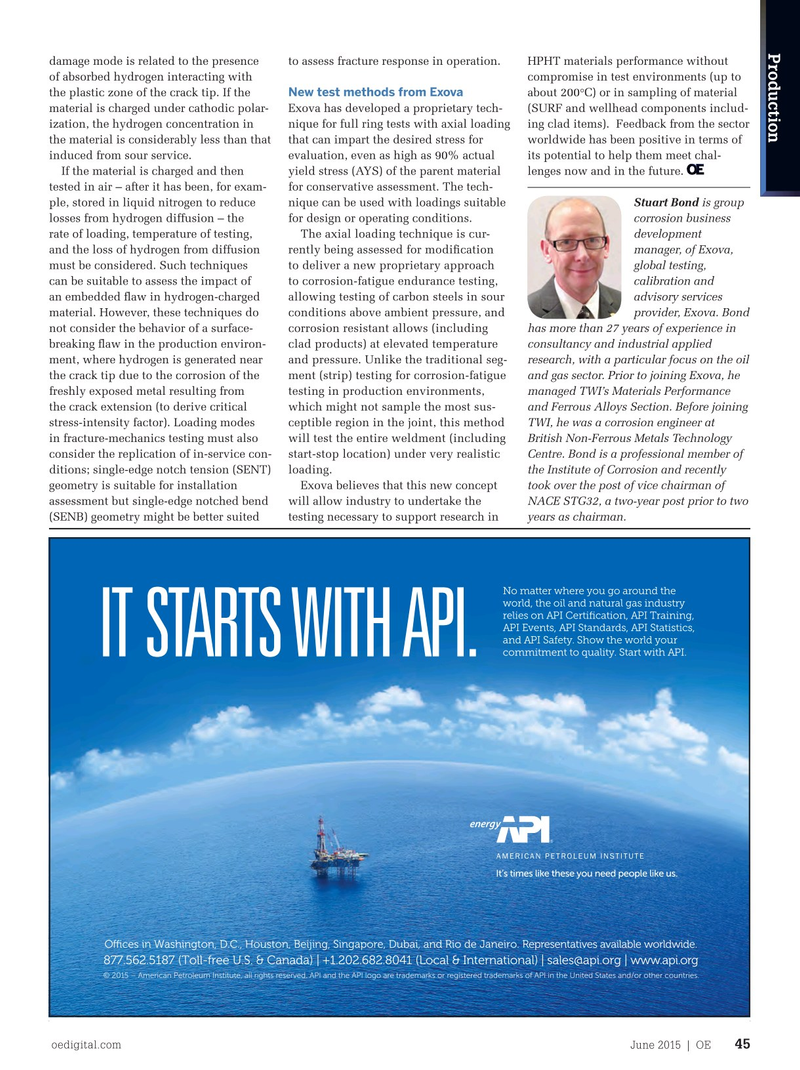
Page 43: of Offshore Engineer Magazine (Jun/Jul 2015)
Read this page in Pdf, Flash or Html5 edition of Jun/Jul 2015 Offshore Engineer Magazine
EyebrowProduction support of the European Federation of damage mode is related to the presence to assess fracture response in operation. HPHT materials performance without
Corrosion Working Party 13 and the two of absorbed hydrogen interacting with compromise in test environments (up to
New test methods from Exova sour service guidance documents (EFC16 the plastic zone of the crack tip. If the about 200°C) or in sampling of material & EF17). material is charged under cathodic polar- Exova has developed a proprietary tech- (SURF and wellhead components includ- ization, the hydrogen concentration in nique for full ring tests with axial loading ing clad items). Feedback from the sector
Testing the material is considerably less than that that can impart the desired stress for worldwide has been positive in terms of
Originally, test methods for sour service induced from sour service. evaluation, even as high as 90% actual its potential to help them meet chal- such as NACE TM0177 (SSC) and NACE If the material is charged and then yield stress (AYS) of the parent material lenges now and in the future.
TM0284 (HIC) were developed to provide tested in air – after it has been, for exam- for conservative assessment. The tech-
QA/QC methods using laboratory test ple, stored in liquid nitrogen to reduce nique can be used with loadings suitable Stuart Bond is group environments, which were formed to losses from hydrogen diffusion – the for design or operating conditions. corrosion business aggressively identify materials suscep- rate of loading, temperature of testing, The axial loading technique is cur- development tible to damage. Now, the industry seeks and the loss of hydrogen from diffusion rently being assessed for modifcation manager, of Exova, to reduce the excessive conservatism this must be considered. Such techniques to deliver a new proprietary approach global testing, approach imposes and the assessment of can be suitable to assess the impact of to corrosion-fatigue endurance testing, calibration and corrosion resistant alloys has increased. an embedded faw in hydrogen-charged allowing testing of carbon steels in sour advisory services
Therefore, more application-specifc material. However, these techniques do conditions above ambient pressure, and provider, Exova. Bond testing has been undertaken to simulate not consider the behavior of a surface- corrosion resistant allows (including has more than 27 years of experience in operating conditions. breaking faw in the production environ- clad products) at elevated temperature consultancy and industrial applied
Corrosion resistant alloys require test- ment, where hydrogen is generated near and pressure. Unlike the traditional seg- research, with a particular focus on the oil ing at elevated temperature and pressure the crack tip due to the corrosion of the ment (strip) testing for corrosion-fatigue and gas sector. Prior to joining Exova, he using autoclaves and 4-point bend (4pb) freshly exposed metal resulting from testing in production environments, managed TWI’s Materials Performance specimens in constant defection (par- the crack extension (to derive critical which might not sample the most sus- and Ferrous Alloys Section. Before joining ticularly for weldments). When ranking stress-intensity factor). Loading modes ceptible region in the joint, this method TWI, he was a corrosion engineer at tests are required to compare materials, in fracture-mechanics testing must also will test the entire weldment (including British Non-Ferrous Metals Technology slow strain rate testing (SSRT) (or ripple consider the replication of in-service con- start-stop location) under very realistic Centre. Bond is a professional member of strain rate testing (RSRT) is used. ditions; single-edge notch tension (SENT) loading. the Institute of Corrosion and recently
Similar considerations apply to the geometry is suitable for installation Exova believes that this new concept took over the post of vice chairman of fracture toughness testing of materi- assessment but single-edge notched bend will allow industry to undertake the NACE STG32, a two-year post prior to two als, such as carbon steels in which the (SENB) geometry might be better suited testing necessary to support research in years as chairman.
– your partner for further education
No matter where you go around the world, the oil and natural gas industry relies on API Certifcation, API Training,
API Events, API Standards, API Statistics, and API Safety. Show the world your commitment to quality. Start with API.
IT STARTS WITH API.
Separation
Technology 2015 – Gas Separation – Heavy Oil Separation – Liquid-Liquid Separation
It’s times like these you need people like us.
– Subsesa Separation 23 and 24 Sept. 2015, Stavanger, Norway
Ofces in Washington, D.C., Houston, Beijing, Singapore, Dubai, and Rio de Janeiro. Representatives available worldwide.
877.562.5187 (Toll-free U.S. & Canada) | +1.202.682.8041 (Local & International) | [email protected] | www.api.org
REGISTRATION: [email protected] © 2015 – American Petroleum Institute, all rights reserved. API and the API logo are trademarks or registered trademarks of API in the United States and/or other countries.
Telephone: +47 22 94 75 60 / 61 www.tekna.no/intconf 2015_OE_HalfPage_StartsWithAPIAd.indd 1 3/23/15 12:47 PM oedigital.com June 2015 | OE 45 042_OE0615_Prod Ops1_H2S.indd 45 6/1/15 2:19 PM

 42
42

 44
44